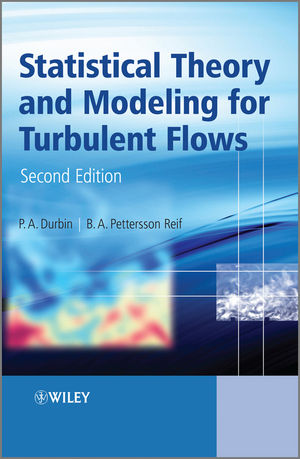Statistical Theory and Modeling for Turbulent Flows, 2nd EditionISBN: 978-0-470-68931-8
Hardcover
376 pages
October 2010
 This is a Print-on-Demand title. It will be printed specifically to fill your order. Please allow an additional 10-15 days delivery time. The book is not returnable.
|
||||||
Preface to second edition.
Preface to first edition.
Motivation.
Epitome.
Acknowledgements.
Part I FUNDAMENTALS OF TURBULENCE.
1 Introduction.
1.1 The turbulence problem.
1.2 Closure modeling.
1.3 Categories of turbulent flow.
Exercises.
2 Mathematical and statistical background.
2.1 Dimensional analysis.
2.1.1 Scales of turbulence.
2.2 Statistical tools.
2.2.1 Averages and probability density functions.
2.2.2 Correlations.
2.3 Cartesian tensors.
2.3.1 Isotropic tensors.
2.3.2 Tensor functions of tensors; Cayley–Hamilton theorem.
Exercises.
3 Reynolds averaged Navier–Stokes equations.
3.1 Background to the equations.
3.2 Reynolds averaged equations.
3.3 Terms of kinetic energy and Reynolds stress budgets.
3.4 Passive contaminant transport.
Exercises.
4 Parallel and self-similar shear flows.
4.1 Plane channel flow.
4.1.1 Logarithmic layer.
4.1.2 Roughness.
4.2 Boundary layer.
4.2.1 Entrainment.
4.3 Free-shear layers.
4.3.1 Spreading rates.
4.3.2 Remarks on self-similar boundary layers.
4.4 Heat and mass transfer.
4.4.1 Parallel flow and boundary layers.
4.4.2 Dispersion from elevated sources.
Exercises.
5 Vorticity and vortical structures.
5.1 Structures.
5.1.1 Free-shear layers.
5.1.2 Boundary layers.
5.1.3 Non-random vortices.
5.2 Vorticity and dissipation.
5.2.1 Vortex stretching and relative dispersion.
5.2.2 Mean-squared vorticity equation.
Exercises.
Part II SINGLE-POINT CLOSURE MODELING.
6 Models with scalar variables.
6.1 Boundary-layer methods.
6.1.1 Integral boundary-layer methods.
6.1.2 Mixing length model.
6.2 The k –ε model.
6.2.1 Analytical solutions to the k –ε model.
6.2.2 Boundary conditions and near-wall modifications.
6.2.3 Weak solution at edges of free-shear flow; free-stream sensitivity.
6.3 The k –ω model.
6.4 Stagnation-point anomaly.
6.5 The question of transition.
6.5.1 Reliance on the turbulence model.
6.5.2 Intermittency equation.
6.5.3 Laminar fluctuations.
6.6 Eddy viscosity transport models.
Exercises.
7 Models with tensor variables.
7.1 Second-moment transport.
7.1.1 A simple illustration.
7.1.2 Closing the Reynolds stress transport equation.
7.1.3 Models for the slow part.
7.1.4 Models for the rapid part.
7.2 Analytic solutions to SMC models.
7.2.1 Homogeneous shear flow.
7.2.2 Curved shear flow.
7.2.3 Algebraic stress approximation and nonlinear eddy viscosity.
7.3 Non-homogeneity.
7.3.1 Turbulent transport.
7.3.2 Near-wall modeling.
7.3.3 No-slip condition.
7.3.4 Nonlocal wall effects.
7.4 Reynolds averaged computation.
7.4.1 Numerical issues.
7.4.2 Examples of Reynolds averaged computation.
Exercises.
8 Advanced topics.
8.1 Further modeling principles.
8.1.1 Galilean invariance and frame rotation.
8.1.2 Realizability.
8.2 Second-moment closure and Langevin equations.
8.3 Moving equilibrium solutions of SMC.
8.3.1 Criterion for steady mean flow.
8.3.2 Solution in two-dimensional mean flow.
8.3.3 Bifurcations.
8.4 Passive scalar flux modeling.
8.4.1 Scalar diffusivity models.
8.4.2 Tensor diffusivity models.
8.4.3 Scalar flux transport.
8.4.4 Scalar variance.
8.5 Active scalar flux modeling: effects of buoyancy.
8.5.1 Second-moment transport models.
8.5.2 Stratified shear flow.
Exercises.
Part III THEORY OF HOMOGENEOUS TURBULENCE.
9 Mathematical representations.
9.1 Fourier transforms.
9.2 Three-dimensional energy spectrum of homogeneous turbulence.
9.2.1 Spectrum tensor and velocity covariances.
9.2.2 Modeling the energy spectrum.
Exercises.
10 Navier–Stokes equations in spectral space.
10.1 Convolution integrals as triad interaction.
10.2 Evolution of spectra.
10.2.1 Small-k behavior and energy decay.
10.2.2 Energy cascade.
10.2.3 Final period of decay.
Exercises.
11 Rapid distortion theory.
11.1 Irrotational mean flow.
11.1.1 Cauchy form of vorticity equation.
11.1.2 Distortion of a Fourier mode.
11.1.3 Calculation of covariances.
11.2 General homogeneous distortions.
11.2.1 Homogeneous shear.
11.2.2 Turbulence near a wall.
Exercises.
Part IV TURBULENCE SIMULATION.
12 Eddy-resolving simulation.
12.1 Direct numerical simulation.
12.1.1 Grid requirements.
12.1.2 Numerical dissipation.
12.1.3 Energy-conserving schemes.
12.2 Illustrations.
12.3 Pseudo-spectral method.
Exercises.
13 Simulation of large eddies.
13.1 Large eddy simulation.
13.1.1 Filtering.
13.1.2 Subgrid models.
13.2 Detached eddy simulation.
Exercises.
References.
Index.



